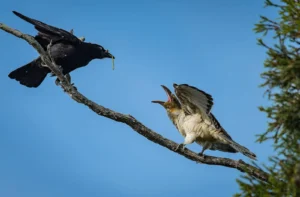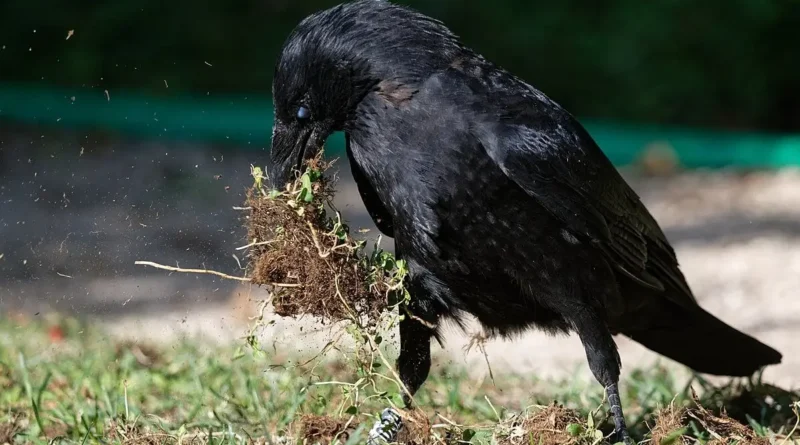What Do Crows Like to Eat
Crows, known for their intelligence and adaptability, are opportunistic omnivores with diverse dietary preferences. These highly adaptable birds can be found in a wide range of habitats, from urban environments to rural landscapes, where they exploit a variety of food sources. Let’s delve into what crows like to eat and uncover the unique aspects of their feeding behaviors.
Introduction: The Versatile Diet of Crows
Crows, members of the Corvidae family, are renowned for their cognitive abilities and problem-solving skills. Their dietary flexibility allows them to thrive in diverse environments by exploiting a wide range of food resources. Understanding their dietary preferences provides insights into their ecological role and foraging strategies.
Natural Diet of Crows

In their natural habitat, crows consume a varied diet that includes:
- Invertebrates: Crows are opportunistic feeders that prey on a variety of invertebrates, including insects, spiders, earthworms, and crustaceans. They use their sharp beaks and agile foraging skills to capture and consume these protein-rich prey items.
- Small Vertebrates: Crows are known to prey on small vertebrates such as frogs, lizards, small mammals (e.g., mice and voles), and birds’ eggs. They are skilled hunters capable of exploiting a wide range of prey species to meet their dietary needs.
- Fruits and Berries: Crows have a keen sense of vision and taste, enabling them to detect ripe fruits and berries from a distance. They feed on a variety of fruits, including apples, cherries, berries, and nuts, especially during the fall and winter months when natural food sources are abundant.
- Seeds and Grains: Crows opportunistically feed on seeds and grains found in agricultural fields, grasslands, and forest clearings. They play a role in seed dispersal by consuming and dispersing seeds across the landscape.
Adaptations for Urban Environments
Crows have successfully adapted to urban environments, where they capitalize on human-associated food sources:
- Human Food Waste: Crows scavenge for discarded food items in urban areas, including leftovers, fast food, and organic waste. They are known to visit garbage bins, dumpsters, and picnic areas in search of accessible food resources.
- Pet Food and Bird Feeders: Crows may opportunistically feed on pet food left outdoors or consume seeds and grains from backyard bird feeders. They are quick learners and can recognize and exploit these supplementary food sources.
- Food from Human Activity: Crows are known to scavenge from agricultural fields, picking off insects disturbed by plowing or harvesting. They also forage around livestock farms, feeding on grains and insects associated with livestock.
Ecological Role of Crows
Crows play a vital ecological role as scavengers, predators, and seed dispersers:
- Scavengers: Crows help clean up decaying organic matter by consuming carrion and discarded food items. They play a crucial role in nutrient cycling and waste disposal within ecosystems.
- Predators: Crows help regulate populations of invertebrates, small vertebrates, and bird species by preying on them. They may contribute to maintaining ecological balance by controlling pest populations.
- Seed Dispersers: Crows aid in seed dispersal by consuming fruits and berries and dispersing the seeds through their droppings. This contributes to plant diversity and regeneration in natural habitats.
Foraging Behaviors and Problem-Solving Skills

Crows exhibit complex foraging behaviors and problem-solving skills:
- Tool Use: Some species of crows, such as New Caledonian crows, are known for their tool-use abilities. They can fashion and use tools to extract food from hard-to-reach places, demonstrating advanced cognitive capabilities.
- Caching Behavior: Crows engage in caching behavior, where they hide excess food in various locations for future consumption. This adaptive behavior helps them cope with food scarcity and seasonal fluctuations in resource availability.
- Social Foraging: Crows often forage in groups, allowing them to share information about food sources and collaborate during scavenging and hunting activities. Social foraging enhances their efficiency in locating and exploiting food resources.
Human-Crow Interactions and Conservation Considerations
Human-crow interactions can be both beneficial and challenging:
- Negative Interactions: Crows may become pests in urban areas, where they scavenge for food scraps and create nuisance behavior. They may also depredate crops or disturb nesting birds.
- Positive Interactions: Crows contribute to urban biodiversity and ecosystem services by controlling pest populations and cleaning up organic waste. They are valuable indicators of environmental health and habitat quality.
Conclusion: The Adaptive Success of Crows
In conclusion, crows’ dietary preferences and foraging behaviors highlight their adaptive success as intelligent and resourceful birds. Their versatile diet, ranging from invertebrates and small vertebrates to fruits, seeds, and human-associated food sources, reflects their ability to thrive in diverse environments. By understanding what crows like to eat and their ecological role, we gain a deeper appreciation for these fascinating birds and their contributions to ecosystem dynamics and urban biodiversity. As we navigate human-crow interactions, it is essential to promote responsible stewardship of urban habitats and foster coexistence with these remarkable avian neighbors.

